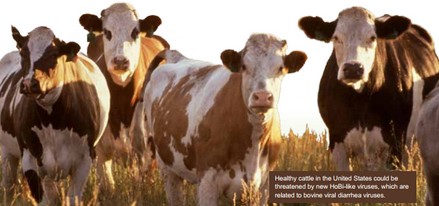Assessing the Risks of HoBi-Like Viruses in Cattle
Published: November 18, 2014
Source : Sandra Avant, USDA, Agricultural Resarch Service (ARS)
Scientists are tracking a new species of pestivirus that could pose a threat to U.S. cattle. Tentatively called “HoBi-like viruses,” they are related to bovine viral diarrhea viruses (BVDV), which cause significant economic losses to cattle producers worldwide. Originally found in South America, HoBi-like viruses have since been associScientists are tracking a new species of pestivirus that could pose a threat to U.S. cattle. Tentatively called “HoBi-like viruses,” they are related to bovine viral diarrhea viruses (BVDV), which cause significant economic losses to cattle producers worldwide.
Originally found in South America, HoBi-like viruses have since been associated with disease outbreaks in Southeast Asia and more recently in Europe. Signs of infection include slowed growth, reduced milk production, higher rates of reproductive and respiratory diseases, and a higher incidence of death among young animals. No vaccines are available to specifically prevent HoBi infection in cattle.
At the Agricultural Research Service’s National Animal Disease Center (NADC) in Ames, Iowa, microbiologist Julia Ridpath and her colleagues are characterizing HoBi-like viruses and determining whether available BVDV diagnostics and vaccines are effective in detecting and preventing them.
“We’ve found that cattle vaccinated against BVDV have little or no protection against HoBi infections,” Ridpath says. “Our current BVDV tests and com mercial vaccines are not adequate to detect HoBi-like viruses and protect cattle against them.”
These findings, published in Veterinary Microbiology and the Journal of Veterinary Diagnostic Investigation, indicate a need for new diagnostics and vaccines specific to these viruses. Ridpath, who is in NADC’s Ruminant Diseases and Immunology Unit, also demonstrated that acute HoBi infections in cattle result in immunosuppression. Like BVDV, HoBi has the ability to cross the placenta, infecting the fetus and establishing a lifelong infection in an animal. Such animals are referred to as “persistently infected.”
“A calf born persistently infected with BVDV is like a ‘Typhoid Mary,’ shedding virus into the environment through its tears, blood, urine, feces, and skin,” Ridpath says. “All of its tissues carry the virus. We have found that the same is true of calves persistently infected with HoBi-like viruses, and they can transmit the virus to other calves, sheep, goats, and pigs.”
Ridpath and her colleagues at NADC are collaborating with researchers in Brazil and Italy to investigate the prevalence of HoBi. In a study published in the Journal of Veterinary Diagnostic Investigation in 2014, the team conducted a survey of fetal bovine serum collected from animals in the United States. No HoBi-like viruses were detected. This suggests that the viruses have not invaded the country.
The first published report of HoBi in European cattle was in a 2010 respiratory disease outbreak. However, ARS scientists and their colleagues from Italy demonstrated that HoBi had been in circulation in Europe earlier than previously reported. They detected the virus in archived samples sent to a diagnostic laboratory in Italy in 2007.
Future efforts will continue to involve conducting immunology surveys to ensure that HoBi-like viruses have not entered the United States, Ridpath says. Additionally, scientists are working to develop tests to screen imported animals and animal products to make sure they are free of these viruses.

This research is part of Animal Health, an ARS national program (#103) described at www.nps.ars.usda.gov.
Julia Ridpath is in the USDA-ARS Ruminant Diseases and Immunology Unit, National Animal Disease Center, 1920 Dayton Ave., Ames, IA 50010; (515) 337-7586, julia.ridpath@ars.usda.gov
Source
Sandra Avant, USDA, Agricultural Resarch Service (ARS)Related topics
Join to be able to comment.
Once you join Engormix, you will be able to participate in all content and forums.
* Required information
Would you like to discuss another topic? Create a new post to engage with experts in the community.
Create a post



.jpg&w=3840&q=75)